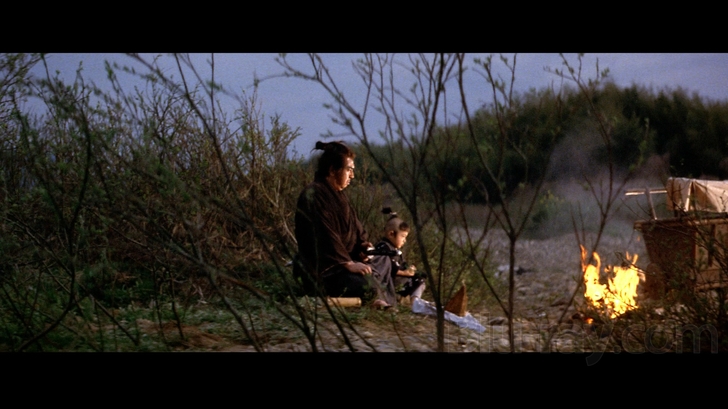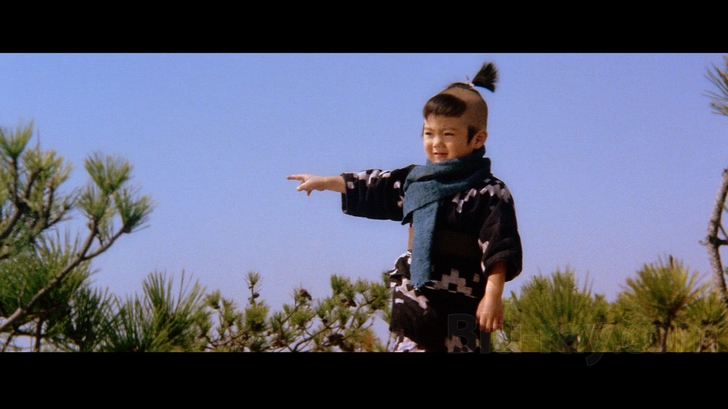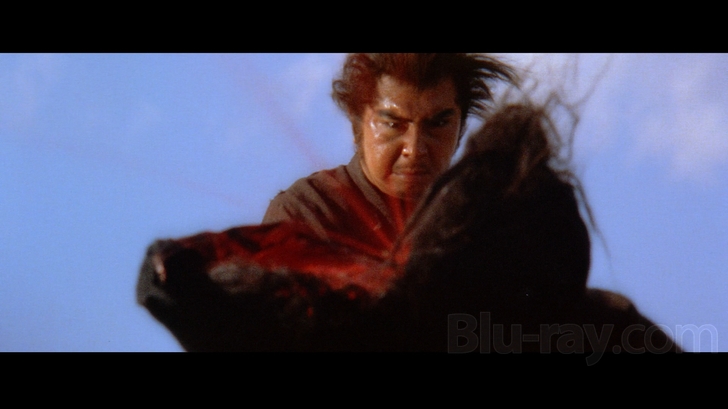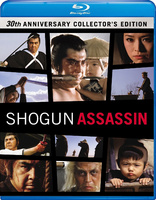Shogun Assassin Blu-ray Movie
HomeShogun Assassin Blu-ray Movie 
AnimEigo | 1980 | 85 min | Rated R | Aug 24, 2010Movie rating
7.8 | / 10 |
Blu-ray rating
| Users | 4.5 | |
| Reviewer | 4.0 | |
| Overall | 4.0 |
Overview
Shogun Assassin (1980)
In a time of evil and tyranny, a stone-faced ronin wanders the countryside with his young son (and a weapon-filled baby cart), hunted by the merciless minions of an evil Shogun. Once a noble samurai, he is now the most feared assassin in Japan, known only as Lone Wolf.
Starring: Tomisaburo Wakayama, Kayo Matsuo, Minoru Ôki, Akiji Kobayashi, Shin KishidaDirector: Robert Houston (I), Kenji Misumi
| Martial arts | 100% |
| Adventure | Insignificant |
| Action | Insignificant |
Specifications
Video
Video codec: MPEG-4 AVC
Video resolution: 1080p
Aspect ratio: 2.43:1
Original aspect ratio: 2.39:1
Audio
English: LPCM 2.0 (48kHz, 16-bit)
Subtitles
None
Discs
25GB Blu-ray Disc
Single disc (1 BD)
Playback
Region A (C untested)
Review
Rating summary
| Movie | 4.0 | |
| Video | 4.0 | |
| Audio | 4.0 | |
| Extras | 2.5 | |
| Overall | 4.0 |
Shogun Assassin Blu-ray Movie Review
Best Western-ized?
Reviewed by Casey Broadwater September 16, 2010Shortly after the massively popular Shogun miniseries aired on U.S. television in 1980, whetting the appetite of American audiences for all things Japanese, a bizarre, bloody, comically violent mash-up samurai movie called Shogun Assassin began making laps on the grindhouse circuit. Samurai Assassin was the brainchild of Robert Houston and David Weisman, who cheaply obtained the rights to the Lone Wolf and Cub samurai film series and decided to re-edit the first two movies—Sword of Vengeance and Baby Cart at the River Styx, both from 1972—into a single action-packed, Americanized adventure. They hired deaf lip-readers to assist with the script, creating an English dub that matched the Japanese actors’ mouths almost perfectly, and vastly simplified the story. The result? A trim, 85-minute exploitation film that’s all muscle and no fat. While the original Lone Wolf and Cub movies are better—specifically in terms of plot and character development—Shogun Assassin is an undeniable cult classic, a gory samurai re-dub that, in its sampled, re-cut, and mashed up aesthetic, left an indelible mark on pop culture, from RZA’s Liquid Swords album to Quentin Tarantino’s similarly hodgepodge Kill Bill.

Lone Wolf and Cub
Shogun Assassin uses about 11 minutes from Sword of Vengeance and the remainder from Baby Cart at the River Styx. To say the plot has been simplified is a gross understatement—all of the political intrigue and factional disputes from the originals are tossed out here in favor of lean, mean swordplay. All that remains are the essentials. A “decapitator” for a corrupt Shogun whose “brain was infected with devils,” Ogami Itto—played by Tomisaburo Wakayama and voiced by radio actor Lamont Johnson—is fed up with doing his feudal lord’s dirty deeds. Ogami quits, but the Shogun sends a team of ninjas to murder his wife in retaliation. Brought to the Shogun’s castle to commit seppuku—ritual suicide—Ogami slices and dices his way out and becomes a ronin, a master-less samurai. Only, he’s no usual wandering swordsman—as he “walks the road of vengeance,” he pushes his toddler son Daigoro (Akihiro Tomikawa, voiced by Gibran Evans) in a tricked-out James Bond-esque baby cart that’s loaded with secret projectile weapons. Daigoro serves as our narrator, giving oddly touching commentary on the action and occasionally serving up a laugh-out-loud-worthy line like, “Sometimes you have to take a chance if you wanna take a bath.” (This, after a tense bathing session at a public indoor onsen.)
Essentially, the plot is reduced to a series of increasingly absurd encounters with the Shogun’s henchmen—and women—as our Lone Wolf and Cub trek around Edo-era Japan. In one scene, we meet a badass gang of female ninjas—their fiercely insane leader voiced by Sandra Bernhard— who hack off all the limbs of a male competitor, leaving only a bloody torso. When these femme fatales meet our hero out on the open road, they attack with all manner of trickery—hiding blades in long Japanese radishes, pretending to be pious pilgrims, even cooing at young Diagoro—but one after another they all fall under the hard steel of Ogami’s sword. The climax is straight out a spaghetti western, as Ogami faces off in the desert against the Three Masters of Death, who each employ a different kind of spiked weapon. And, of course, there are numerous nameless thugs throughout, whose sole purpose is to be creatively slain. The violence in the film was shocking for its time—partly a ploy to bolster flagging Japanese cinema attendance—and I’d even venture to say there’s more arterial bloodletting in Shogun Assassin than in Evil Dead and Evil Dead II combined. All of the spurting and spraying gets to be quite comical, so if you’re the sort to get a giddy sugar high off of extremely stylized limb-lopping, head-splitting, and neck-skewering, you’ll be bouncing off the walls with sick glee by the time Shogun Assassin is over.
The violence is tempered only by the incongruous tenderness between Ogami and Daigoro, and it’s this aspect of the film that elevates Shogun Assassin from mere exploitation schlock to bonafide cult classic. The father/son relationship is like a bizarre precursor to the one in Cormac McCarthy’s The Road. My two favorite scenes in the film are 1.) when Daigoro carries water from a stream in his cheeks and spits it into the mouth of his wounded, near-death father, and 2.) when Ogami rescues his son from bandits who threaten to drop the boy down a well. Given all of the similarities—the life or death struggle, the on-the-road wariness, a father pushing his son in a cart through an inhospitable landscape—it seems like McCarthy had to have seen the Lone Wolf and Cub movies at some point in time. (Any desperate film studies students in need of a master’s thesis?) It should also be said that, unlike many exploitation films—with low budgets and even lower production standards—Shogun Assassin is a handsome movie, with convincing period-piece details, colorful cinematography, and a keen sense of composition. The dubbing, in this westernized version, is surprisingly decent as well. Samurai film fans should eventually track down the original Lone Wolf and Cub movies—for the full story—but Shogun Assassin earns a spot beside Godzilla as one of the best Japanese films modified for an American audience.
Shogun Assassin Blu-ray Movie, Video Quality 

Here's something you don't see everyday. Instead of running an old negative of Shogun Assassin through a telecine machine, AnimEigo opted to reconstruct the entire film from the best available elements—that is, negatives from the original Lone Wolf and Cub films. They literally re-edited each cut and transition, matching their work to a master copy of Shogun Assassin, and the improvement is drastic. This 1080p/AVC-encoded transfer is light-years beyond previous DVD incarnations, and it doesn't even exist in the same universe as the ratty VHS dupes that, for a long time, were the only way to see Shogun Assassin at home. In the special features, you can actually watch a comparison between a bootleg, a DVD, and this Blu-ray. It goes without saying that the difference is immediate and immense.There are white specks on the print in almost every scene here, and you'll occasionally spot brief vertical scratches, but aside from the age-related wear 'n' tear, this presentation is very strong. Clarity gets a huge boost; many shots look quite soft compared to the best Blu-ray has to offer, but close-ups are sharp—you can even make out the adhesive tape that holds on the Shogun's eyebrows—and I really don't think much more could be done with the source material. Color is strong as well, with rich woodsy interiors, pale blue skies, even skin tones, and, of course, gallons of Crayola-red blood. Darker scenes are subject to good deal of black crush, but once again, this is probably inherent in the source. There are no DNR or edge enhancement abuses, and I didn't spot any compression-related distractions besides a few instances of splotchy color gradients. The only stand-out wait, what's going on here moments are two extremely brief establishing shots of castles that were nabbed from a noticeably low-rez stock footage source. Each lasts only a few seconds. Overall, I don't think fans could've asked for more.
Shogun Assassin Blu-ray Movie, Audio Quality 

Rather than trying to expand Shogun Assassin's soundtrack into a 5.1 presentation, AnimEigo wisely stuck with the original mono, reproduced here by way of an uncompressed English Linear PCM 2.0 mix. Of course, the most distinctive audio element of the film is the groovy Moog synthesizer score by Paul Revere and the Raiders frontman Mark Lindsay, which sounds fantastic. (It's not entirely unlike something you'd hear in an early John Carpenter film.) Cues from the original Lone Wolf and Cub films are included as well, and the music as a whole has a nice sense of presence. Otherwise, the mix is very minimalist. The sound design for the action sequences is sometimes bizarrely stylized; occasionally, all noises will drop out of the mix but the swishing of Ogami's sword as he hews down his foes. Elsewhere, Daigoro's voice-overs take precedence, oddly calling to mind the narration in Terence Malik's Days of Heaven. The dialogue—such as it is—is balanced in the mix and always easy to understand. No real problems here.
Shogun Assassin Blu-ray Movie, Special Features and Extras 

Audio Commentaries
There are two tracks here. The first, which appeared on the DVD, features film scholar Ric Meyers and martial arts expert Steve Wilson discussing the
Lone Wolf and Cub films, elucidating obscure elements of Japanese tradition, and commenting on the film's sword-based action. The second is an
all-new track with producer Davis Weisman, graphic designer Jim Evans (Illustrator), who designed the poster art, and Gibran Evans, who provided the
voice of Daigoro when he was seven years old. This track focuses more keenly on the origin of the Shogun Assassin project and the process of
reworking the Lone Wolf films for an international audience.
Samuel L. Jackson Interview (1080p, 12:43)
Everyone's favorite Jedi is a huge martial arts movie fan, and in this 2009 interview, Jackson talks extensively about his love for Lone Wolf and
Shogun Assassin.
Restoration Gallery (1080p, 3:45)
A showcase of the visual difference between bootleg, DVD, and Blu-ray copies of the film.
Program Notes
Text-only trivia and notes on the high definition remastering process.
HD Trailer (1080p, 2:35)
Shogun Assassin Blu-ray Movie, Overall Score and Recommendation 

Cannibalized from the first two Lone Wolf and Cub films, Shogun Assassin is pure, visceral entertainment—there's no real plot to speak of, just non-stop limb-lopping, head-cleaving, blood-spurting samurai action. It's mindless, sure, but it's stylish, campy, darkly funny—sometimes unintentionally—and an absurdly good time. AnimEigo has done a terrific job with this release, assembling an all-new transfer out of the best available source materials, providing an uncompressed audio track, and delivering two informative commentaries. It'll never best the originals, but Shogun Assassin is impossibly fun any way you slice it.
Similar titles
Similar titles you might also like

Lone Wolf and Cub: Baby Cart at the River Styx
Kozure Ôkami: Sanzu no kawa no ubaguruma
1972

Lone Wolf and Cub: White Heaven in Hell
Kozure ôkami: Jigoku e ikuzo! Daigorô
1974

Lone Wolf and Cub: Sword of Vengeance
Kozure ôkami: Ko wo kashi ude kashi tsukamatsuru
1972

Lone Wolf and Cub: Baby Cart in the Land of Demons
Kozure Ôkami: Meifumadô
1973

Lone Wolf and Cub: Baby Cart in Peril
Kozure Ôkami: Oya no kokoro ko no kokoro
1972

Lone Wolf and Cub: Baby Cart to Hades
Kozure Ôkami: Shinikazeni mukau ubaguruma
1972

The Tale of Zatoichi
座頭市物語 / Zatôichi monogatari
1962

Zatoichi the Outlaw
座頭市牢破り / Zatôichi rôyaburi
1967

Zatoichi in Desperation
新座頭市物語・折れた杖 / Shin Zatôichi monogatari: Oreta tsue
1972

Zatoichi Goes to the Fire Festival
座頭市あばれ火祭り / Zatôichi abare-himatsuri
1970

Zatoichi Challenged
座頭市血煙り街道 / Zatôichi chikemuri kaidô
1967

Zatoichi at Large
座頭市御用旅 / Zatôichi goyô-tabi
1972

Five Element Ninjas
五遁忍術 / Ren zhe wu di
1982

Dragon Inn
龍門客棧 / Long men kezhan
1967

Last Hurrah for Chivalry
豪俠 / Háo xiá
1979

Six-String Samurai 4K
1998

Zatoichi: Darkness Is His Ally
1989

13 Assassins
Jûsan-nin no shikaku
2010

Blade of the Immortal
無限の住人 / Mugen no jûnin
2017

Fight, Zatoichi, Fight
座頭市血笑旅 / Zatôichi kesshô-tabi
1964


